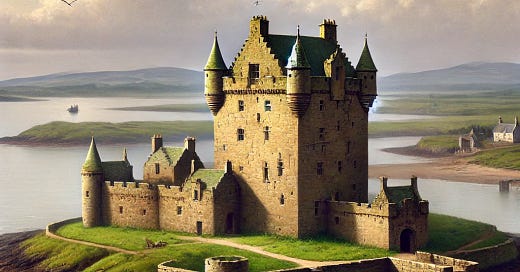Tucked away on a low-lying peninsula projecting into the Firth of Forth lies Rosyth Castle, a haunting, moss-clad ruin that whispers tales of nobility, rebellion, and resilience. Once surrounded entirely by water at high tide, the castle now stands marooned on dry land due to land reclamation and development in the area. Today, it is partially obscured by industrial estates and port activity, but in centuries past, Rosyth was a powerful seat of the Stewart family, closely tied to the royal lineage and fiercely loyal to the Crown during Scotland’s turbulent civil and religious upheavals.
The square grey tower of Rosyth Castle still rises defiantly, a relic of medieval Scotland that once stood watch over the sea lanes leading into the heart of the kingdom. Though now silent, its stones remember a time when allegiance was dangerous, and loyalty could cost a life—or a legacy.
The Stewart Lineage: From Durisdeer to Rosyth
Rosyth Castle’s earliest known owners were the Stewarts of Rosyth, a cadet branch of the royal House of Stewart. Their ancestral line can be traced to James Stewart of Durisdeer, the brother of Walter the Steward, who married the daughter of Robert the Bruce and fathered Robert II, the first Stewart king of Scotland. This made the Rosyth Stewarts distant but legitimate kin to the royal family—never quite at the center of power, but always close enough to feel its tremors.
The earliest confirmed Stewart owner of Rosyth was Sir David Stewart of Durisdeer, who acquired the barony in the 15th century and built the original structure of the castle. Sir David was a man of learning and patron of the famed chronicler Walter Bower, abbot of Inchcolm and continuator of John of Fordun’s Scotichronicon. Bower himself may have visited Rosyth Castle, pen in hand, weaving the early Stewart legacy into Scotland’s official memory.
But the family's ambitions—and political stance—would soon place them in more dangerous waters.
Fierce Royalists in a Time of Turmoil
Throughout the 16th and 17th centuries, the Stewarts of Rosyth emerged as unwavering Royalists, aligning themselves with the monarchy even as Scotland’s political landscape fractured under the weight of Reformation, civil war, and Cromwell’s military machine.
When the Covenanters—those staunch defenders of Presbyterianism—rose in opposition to royal interference in the Church of Scotland, the Stewarts were firmly on the side of the Crown. Their position wasn’t merely ideological; it was strategic, rooted in loyalty, lineage, and land. But Royalist allegiance carried a heavy price during Scotland’s wars of the three kingdoms.
In the 1650s, as Oliver Cromwell’s army invaded Scotland, the Stewarts of Rosyth suffered harsh retribution. Records indicate that the family’s woods at "Hnirschaw" were ordered to be felled—not to build siege engines or warships, but simply to rebuild villages and towns destroyed by Montrose’s Royalist forces, an ironic twist of justice. In a world where war meant the burning of barns and the tearing down of walls, the Royalist Stewarts became a source of construction material, their wealth sacrificed to pay for their side’s sins.
Further damage likely followed during Cromwell’s occupation of the Forth, as Inchgarvie, North Queensferry, and the surrounding areas were militarized and fortified. Rosyth Castle, so close to the water and strategic shipping lanes, would have been well within the scope of surveillance—or seizure.
Decline, Legacy, and the Quiet Echoes of History
After the Restoration of Charles II, many Royalist families hoped to reclaim lost status. But the Stewarts of Rosyth did not bounce back. By the end of the 17th century, they had sold their estates, and the barony of Rosyth passed through several hands—including the Earls of Rosebery—before eventually ending up in the possession of the Hopetoun family, whose descendants still hold it today.
The castle itself fell into disrepair. Yet remnants of its glory remain.
Step inside Rosyth Castle and you’ll find a spacious hall with cross-mullioned windows, a reminder that the Stewarts once hosted nobility here. One of the windows still bears a carving with the initials "F.S." and "M.N." alongside the date 1639—likely a wedding or commemorative inscription, etched during the family’s final years of influence.
Above the entrance once hung a peculiar piece of verse, now barely legible:
“In dew tym draw this cord the pei, to clink,
qvhais mery voce varnis to meat and drink.”
This poetic charm—translated loosely as "In due time draw this cord, the bell will clink, whose merry voice invites to meat and drink"—evokes the sound of a dinner bell, a warm invitation to hospitality within these once-grand walls.
Over the gateway still lingers a faded coat of arms and a crown, with the inscription “M.R. 1561,” possibly marking a visit by Mary, Queen of Scots, to her distant kin at Rosyth.
Today, Rosyth Castle is but a ghost of its former self. Industrial encroachment has dimmed its romantic silhouette, and modern port operations dominate the nearby coast. But the castle remains a rare and vital window into a lesser-known chapter of Scotland’s Royalist heritage—a quiet, stubborn monument to a family that stood by its kings, even as the world changed around them.





